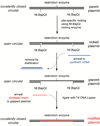Transcription inhibition by platinum-DNA cross-links in live mammalian cells
- PMID: 20443565
- PMCID: PMC2877768
- DOI: 10.1021/ja101495v
Transcription inhibition by platinum-DNA cross-links in live mammalian cells
Abstract
We have investigated the processing of site-specific Pt-DNA cross-links in live mammalian cells to enhance our understanding of the mechanism of action of platinum-based anticancer drugs. The activity of platinum drugs against cancer is mediated by a combination of processes including cell entry, drug activation, DNA-binding, and transcription inhibition. These drugs bind nuclear DNA to form Pt-DNA cross-links, which arrest key cellular functions, including transcription, and trigger a variety of responses, such as repair. Mechanistic investigations into the processing of specific Pt-DNA cross-links are critical for understanding the effects of platinum-DNA damage, but conventional in vitro techniques do not adequately account for the complex and intricate environment within a live cell. With this limitation in mind, we developed a strategy to study platinum cross-links on plasmid DNAs transfected into live mammalian cells based on luciferase reporter vectors containing defined platinum-DNA lesions that are either globally or site-specifically incorporated. Using cells with either competent or deficient nucleotide excision repair systems, we demonstrate that Pt-DNA cross-links impede transcription by blocking passage of the RNA polymerase complex and that nucleotide excision repair can remove the block and restore transcription. Results are presented for approximately 3800-base pair plasmids that are either globally platinated or carry a single 1,2-d(GpG) or 1,3-d(GpTpG) intrastrand cross-link formed by either cis-{Pt(NH(3))(2)}(2+) or cis-{Pt(R,R-dach)}(2+), where {Pt(NH(3))(2)}(2+) is the platinum unit conveyed by cisplatin and carboplatin and R,R-dach is the oxaliplatin ligand, R,R-1,2-diaminocyclohexane.
Figures






References
-
- Kelland L. Nat. Rev. Cancer. 2007;7:573–584. - PubMed
-
- Horwich A, Shipley J, Huddart R. Lancet. 2006;367:754–765. - PubMed
-
- Keys HM, Bundy BN, Stehman FB, Muderspach LI, Chafe WE, Suggs CL, 3rd, Walker JL, Gersell D. N. Engl. J. Med. 1999;340:1154–1161. - PubMed
-
- Jamieson ER, Lippard SJ. Chem. Rev. 1999;99:2467–2498. - PubMed
-
- Wang D, Lippard SJ. Nat. Rev. Drug Discover. 2005;4:307–320. - PubMed
Publication types
MeSH terms
Substances
Grants and funding
LinkOut - more resources
Full Text Sources
Other Literature Sources

